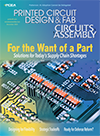Features Articles
 “Without capacity, there is no growth.”
“Without capacity, there is no growth.”
As I write this column, the duty rate for 2- and 4-layer rigid printed circuit boards manufactured in China stands at 145%, while 6-layer and above – along with all other technologies, whether rigid, flex or metal – remains at 170%.
 AI chips could drive technical innovation in fields from PCB materials to district heating
AI chips could drive technical innovation in fields from PCB materials to district heating
The semiconductor business as we know it today represents a tremendous global success story, achieving consistent and strong growth year on year. Analysts expect it to exceed $1 trillion in sales by 2030, and some predict a further doubling over the following decade. The overall figures are extremely impressive, although some sectors are stronger than others. While automotive has enjoyed a strong run for many years as vehicles have electrified, recent performance fell below expectations.
 Driven by tax incentives and tariffs, more US companies are committing to localization.
Driven by tax incentives and tariffs, more US companies are committing to localization.
Because the US trade deficit in goods and services continues to surge, many people wonder if reshoring is really happening and whether its effects are beneficial.
 A discussion with PCBAA president Shane Whiteside.
A discussion with PCBAA president Shane Whiteside.
I recently sat with Shane Whiteside, president and CEO of Summit Interconnect, in his capacity as chairman of the Printed Circuit Board Association of America (PCBAA), to discuss the state of the PCB industry and the effects of the additional tariffs currently in place.
Whiteside’s PCB manufacturing and leadership career spans several decades, which lends itself well to PCBAA’s mission to advocate for a stronger US PCB industry. The association is working hard to educate and influence those in Washington, DC on the importance of a secure US electronics supply chain.
 Routing flash has EMI implications. Don’t rush.
Routing flash has EMI implications. Don’t rush.
Memory comes in different types, and one key distinction is whether the memory remembers anything once the system is shut down. Nonvolatile memory stays around for the next session, while volatile memory lives up to its name and melts away between uses.
 The automotive high-technology race is now as important to governments as it is to the industry itself.
The automotive high-technology race is now as important to governments as it is to the industry itself.
In September 2024, the Biden administration announced a ban on Chinese connected car technology, including hardware and software. This came on top of existing policies including a 100% tariff on Chinese electric vehicles and withdrawal of the government’s $7,500 EV-purchase subsidy for vehicles built with Chinese-made components. Apparently, after imposing the tariff and purchase disincentive, the government decided more measures were needed to protect the American auto industry adequately, including extending the protection to include software. Hence the ban on connected car tech.


